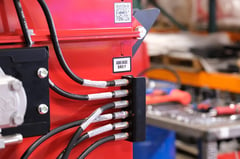Innovative Equipment Engineered to Last
Discover Barreto Manufacturing's 40 years of innovative, durable landscaping equipment, along with expert tips and local highlights for your projects.
Equipment Uptime & Service Tips
Equipment uptime is crucial for a flourishing rental business. Sometimes in the hustle of busy days, simple maintenance tasks get pushed to the side or forgotten. What may seem like an inconsequential detail can soon sprout further problems, so it’s important to adhere to a few “Rental Basics” to take care of your equipment and maximize your return on investment.
Rental equipment can only make you money if it’s functioning out in the field. We recommend the following basics to keep your operation running smoothly:
- Application
- Training
- Grease It
- Tighten Up
- Inspect, Every Time
Application
The first basic rental tip is to help the customer choose the proper machine for the job. Ask what project they intend to use the equipment for. Are they grinding one small stump, or twenty large ones? Selecting the right machine for the workload will position the equipment to perform to the best of its ability, and will help alleviate unnecessary wear and tear.
If the customer uses a small, wheeled stump grinder to grind twenty large stumps, they will put many more hours on the unit and burn through cutter teeth at a fast rate. This creates more wear on the unit overall and opens the door for damage to other parts of the machine. If using a larger, tracked model that is designed for heavy use on larger stumps the customer will accomplish their task faster and easier with less wear to the machine.

Training
Beyond simple mechanics, there’s a largely human component to equipment uptime (and more specifically, downtime). Training becomes essential, both for your personnel behind the shop doors and for the customers who walk out with your equipment. Uptime involves first starting with quality equipment, and extends to training all users on its operation, like the specifics for each knob, lever, and switch.
We all know that rental equipment undergoes extreme abuse - both experienced and inexperienced users will have their hands behind the wheel of your precious business assets, and the damage from inattentive users can be costly. It pays great dividends to take one-on-one time with customers to walk through proper startup, operating, and shutdown procedures.
This is no doubt part of your rental process already, but selecting proficient trainers and emphasizing key components will help eliminate common errors while empowering users with the experience and knowledge they need to run the equipment the way it was meant to be run. Familiarity with the equipment is key to a successful rental - not to mention it is crucial for operator safety.

Grease It
Those grease zerks exist for a reason! It might sound overly simplified, but one of the easiest ways you can prevent wear on your machines is to properly and frequently grease them. Greasing after each rental ensures that moving parts have the lubrication they need to keep operating freely and minimize repetitive wear.
Without frequent greasing, you run the risk of wear parts binding up, wearing down, or corroding by exposure to environmental conditions like mud and water. Prevent excessive machine wear and tear by applying high pressure, high wear industrial grease wherever equipment requires it. Usually, manufacturers label each grease zerk on the equipment itself, so consider making a checklist or posting the grease schematic in a prominent place where service techs will easily see and apply it.

Tighten Up
We’ve all heard the old adage “If it ain’t broke, don’t fix it.” We also know that with rental equipment, unfortunately, this does not always apply. Be proactive by performing routine maintenance before a full blown repair is needed.
Loose bolts, wiggly fittings, and any hoses or parts that are not properly secured will make for headaches later when they have slowly worked their way off the equipment with use. Sure, you can always order replacement parts, but between the time spent diagnosing the problem and the cost of shipping, and by the time the replacements are sourced and in hand, your equipment has been riding the bench long enough to stop earning its keep in the field.
The only way to diagnose a potentially problematic fitting is to check it. Check fittings each and every time units return from a jobsite and save yourself the costs of running them beyond their capabilities.
Inspect, Every Time
After 38 years in the equipment industry, we see common trends in service requests and customer feedback. One of the main complaints we see is that maintenance crews are not thoroughly inspecting units each and every time they come back from rental.
Say for example that a customer returns a stump grinder with a broken tooth. Without fixing it, that grinder goes back out to the field, and the broken tooth begins to damage the tooth holder. This in turn creates more resistance on the overall cutter wheel, and the resistance begins to wear out the bearings. More times than not, small damages become multifaceted maintenance issues quickly - which are costly and ultimately do not increase your bottom line.
Perhaps shop crews would benefit with a “Rent-Ready” checklist - basically some form of systems-check, procedure, or a standardized process that is easily followed to ensure the equipment is thoroughly inspected before it may go back out the door.
Being proactive about what constitutes a rent-ready machine, and carefully inspecting each unit upon every return from the field is the best solution for knowing your equipment is safe, functional, and ready for many rentals to come.
